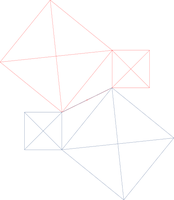junqian2020
New member
- Joined
- Jul 4, 2021
- Messages
- 1
Hi.. I would like some help regarding this problem...
Given Triangle DEF. Let points A and B, drawn externally to Triangle DEF, be the center of squares having DE and EF as sides, respectively. Let C be the midpoint of DF. Show that performing RB,90O(RA,90O(X)) is the same as performing RC,180O(X), with X being an arbitrary point in the plane.
I observed that performing RB,90O(RA,90O(D)) and RC,180O(D) produced the same image for D. I am thinking of using the concept that a rotation at some center A with an angle X and followed by another rotation about a point B with an an angle Y, is a rotation at some point C with an angle X + Y (as long as X + Y is not a multiple of 2pi). However, it seems that just saying, "Since RB,90O(RA,90O(X)) is a composite rotation with a total angle of 180O (not a multiple of 2pi) then there exists a point C such that RC,180O(X) produces the same rotation." is not enough since I did not use the fact that D,E and F forms a triangle and that A and B are centers of two different squares. I would like to ask for help regarding this. Thank you.
Given Triangle DEF. Let points A and B, drawn externally to Triangle DEF, be the center of squares having DE and EF as sides, respectively. Let C be the midpoint of DF. Show that performing RB,90O(RA,90O(X)) is the same as performing RC,180O(X), with X being an arbitrary point in the plane.
I observed that performing RB,90O(RA,90O(D)) and RC,180O(D) produced the same image for D. I am thinking of using the concept that a rotation at some center A with an angle X and followed by another rotation about a point B with an an angle Y, is a rotation at some point C with an angle X + Y (as long as X + Y is not a multiple of 2pi). However, it seems that just saying, "Since RB,90O(RA,90O(X)) is a composite rotation with a total angle of 180O (not a multiple of 2pi) then there exists a point C such that RC,180O(X) produces the same rotation." is not enough since I did not use the fact that D,E and F forms a triangle and that A and B are centers of two different squares. I would like to ask for help regarding this. Thank you.


